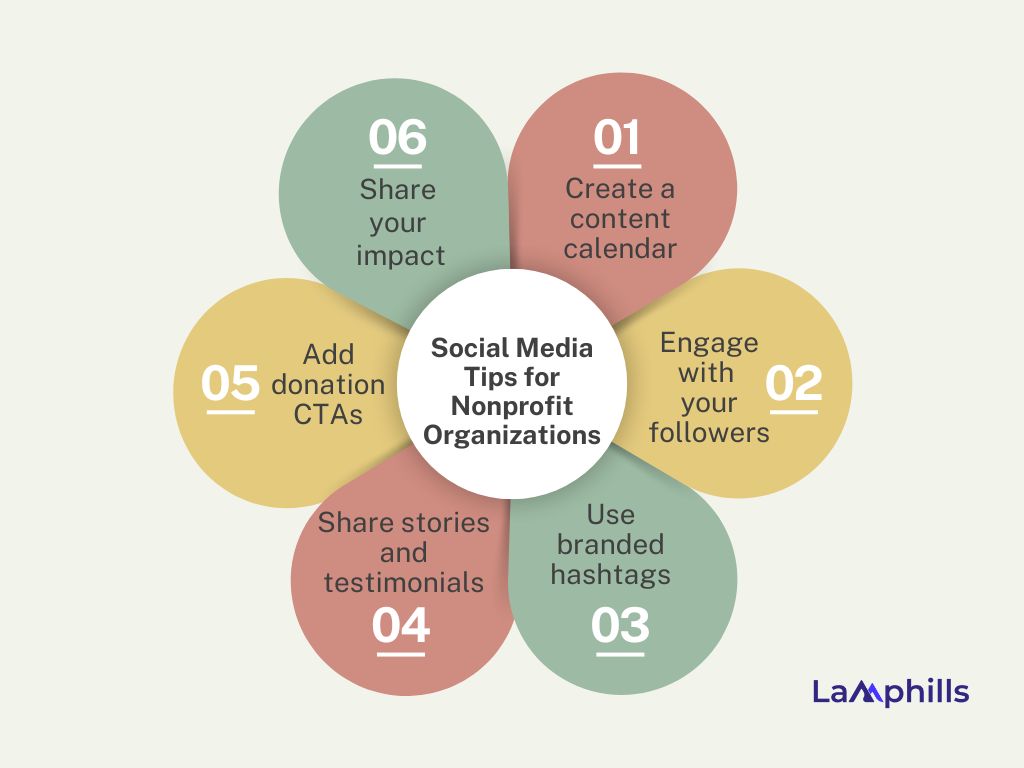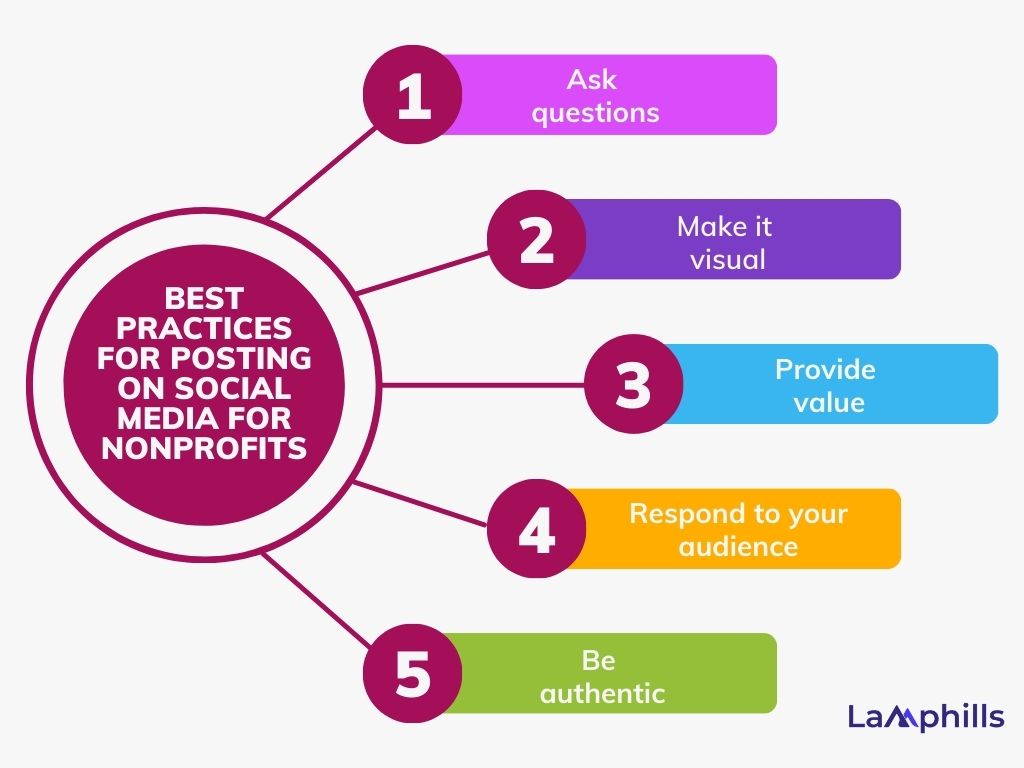If you’re running nonprofits, you have an incredible opportunity to connect with supporters on social media. With over 4 billion users worldwide, that’s a large audience just sitting there, ripe for the picking. But how do you go about it?
Well, I am happy to inform you that social media for nonprofits doesn’t have to be an overly complicated journey. Yes, there are a few steps you need to follow, but it’s no rocket science.
Key Takeaways
- The first step to using social media for nonprofits is to settle on the right platform for your organization.
- From there, you can use a variety of social media tools and strategies to post engaging content to the right audience.
- Social media helps create awareness for your nonprofit efforts and attract donors, among other benefits.
- Nonprofit organizations should create a social media content calendar to plan and schedule their posts in advance.
- There are several best practices you can follow that will help you develop engaging content, no matter what kind of organization you are in.
Which Social Media Platform Is Best For Nonprofits?
Many nonprofits enter the social media game believing they should be on as many platforms as possible. In actuality, each platform caters to different demographics. By choosing one or two platforms, you can target a specific audience that is more likely to be interested in and engage with your content.
Facebook has nearly 3 billion users, proving its enormous impact on social media worldwide. It’s not just about the site’s quantity, however. With a primary demographic between the ages of 25 and 35, Facebook offers plenty of tools for nonprofits, including fundraising.
Here, your nonprofit can easily set up a fundraising campaign and receive donations online. You can also create a donation button on your profile, posts, or ads.
Besides fundraisers, there’s the possibility to stream live videos, broadcast events your nonprofit holds, or share text or visual content. It’s a good opportunity to appeal to a large audience.
Instagram is owned by Meta, the same company that owns Facebook. As a result, there are many of the same features available on Instagram as there are on Facebook. However, Instagram’s demographics are not exactly the same as Facebook’s.
Instagram tends to skew to a slightly younger crowd with nearly 62% of Instagram users between the ages of 18 and 34. And, while most social platforms skew more heavily toward male users, Instagram splits the gender gap nearly down the middle with the percentage of male users only slightly higher than females at 49.3% female to 50.7% male.
For nonprofits, the biggest feature is Instagram fundraising. You can incorporate donation buttons or stickers on Instagram stories or profiles to encourage action or host a live fundraising event.
Keep in mind that Instagram is a visual platform for sharing photos or videos. Therefore, it’s an ideal option if you want to post visual content but not as effective if you’d like to share text-heavy pieces.
LinkedIn differs from other social media sites on this list as it’s geared more toward business professionals. Its primary user demographic falls between the ages of 46 and 55.
With this demographic, LinkedIn provides your nonprofit opportunities to network professionally with potential partners, donors, volunteers, or even employees. Moreover, you can post more in-depth pieces that explore your organization and share insights on your progress.
Also, in recent years, LinkedIn launched LinkedIn Live to allow your organization to stream live videos from your profile. This live platform is a good choice for hosting panel discussions or events.
TikTok
Lastly, there is TikTok. The biggest audience of TikTok sits between 10 and 19 years old, giving it a very different appeal than sites like Facebook.
Here, users share and watch videos that speak on the latest cultural trends. As a result, there’s less direct promotion of organizations here than there are viral marketing videos. Brands often make TikTok videos or work with influencers to increase brand awareness.
If you simply want to get the message out about your organization to the younger generation, in an entertaining way, TikTok is the right choice.
Once you’ve chosen which platform to use, you can start developing your nonprofit social media strategy. Below is a checklist I have curated which outlines all the steps you need to take:
Creating a Social Media Strategy For Your Nonprofit
You’re missing out if your nonprofit doesn’t have a social media presence yet. As mentioned earlier, there are over 4 billion social media users worldwide, a number that is growing yearly. This means that if you want to spread the word about your cause, social media offers you access to a massive potential audience.
Here’s how nonprofits can make the most of social media.
Social Media Strategy For Your Nonprofit
Social Media Tips for Nonprofit Organizations

Create a content calendar
Nonprofit organizations should create a social media content calendar to plan and schedule their posts in advance. By doing this, they can rest assured that their social media accounts are constantly being updated with fresh and engaging content.
A content calendar will also help them make note of the performance of their posts via insightful analytics. As you may already know, there are several tools and platforms that nonprofits can use to post content more efficiently.
You can sort your upcoming content into categories and schedule them at the best times for increased reach.
Engage with your followers
Don’t be afraid to engage with your followers directly on social media. Make it your daily habit to promptly respond to comments and questions from followers. With time, you’ll build relationships with them by showing them that you care deeply about their input.
Make sure that you have a designated person who responds to comments and questions from followers on social media. This member of your team should remain professional at all times and encourage followers to share their views whenever it’s necessary.
Use branded hashtags
Did you know that using hashtags can increase your Twitter engagement by 100%? That’s yet another reason to give hashtags a try.
NGOs should leverage the power of hashtags on social media to boost awareness of their cause and connect with interested donors. Hashtag campaigns are a great way to get your message out there and inform you of how popular your campaign is. When used correctly, they can help boost engagement and reach a wider audience.
Here are four tips for using branded hashtags effectively:
- Keep your hashtag short and easy to remember
- Add relevant keywords to your hashtag
- Make sure your hashtag is unique to your organization or campaign
- Promote your hashtag on all of your social platforms
Share stories and testimonials
Real-life stories and testimonials are a great way to engage followers on social media and encourage them to start giving. They also enable people to connect with the stories of the people that you have helped.
Nonprofits should regularly share stories and testimonials on social media. Too much is never enough in this case. This can be easily done with engaging social media content that showcases your day-to-day processes, the people you’re helping, and the people who contribute with generous donations.
Here are three ways you can use stories and testimonials:
- Highlight testimonials in social media posts – Incorporate quotes from donors and use images of them to emphasize the positive impact the NGO has had on social media.
- Create social media campaigns around testimonials – NGOs can run testimonial campaigns on their social media accounts, such as a “Stories of Impact” campaign, in which beneficiaries, volunteers, and supporters share their stories.
- Encourage user-generated content – Create challenges, utilize hashtags, and offer incentives for supporters to share their experiences with the NGO.
Add donation CTAs
It’s important to keep in mind what will motivate potential donors when writing social media posts to promote donations. The power of a well-written CTA is unbeatable. Therefore, make sure that your copywriter knows what they’re doing.
Here are some effective CTA for raising donations:
- Ask donors to support a specific campaign or goal by explaining the purpose of the campaign, its goals, and how it will make a positive impact.
- Explain how donations will be used by reminding your followers about the people they’ll support and showcasing images and videos to further incentivize them to take a stand.
- Share stories and testimonials about how the organization has helped people in the past, such as Reels of success stories, YouTube testimonials from donors, and images of the people whose lives have been changed for the better accompanied by compelling descriptions that target emotions.
- Offer exclusive donor perks and rewards for contributing, such as giveaways, badges, or exclusive content.
Share your impact
When it comes to social media for nonprofits, another important goal is to share the charity’s impact. Several methods can be used for this, such as sharing success stories, highlighting volunteers, or promoting donations.
Existing and prospective donors wish to see the positive effects of their contributions. Additionally, social media can be used to connect with other charities and form partnerships. This can help further your charity’s reach and impact.
To maximize the impact of nonprofits on social media, you must keep one goal in mind: always spread the word about the great work you do.
Benefits of Social Media for Nonprofits
Promote awareness of your cause
Drum up support for your cause via educational posts. People can’t get behind you if they don’t know what you’re all about, right?
Social media is an easy, effective way to spread the word about your organization’s mission. People aren’t just on social media to connect with friends. They’re there to learn about the world, to be informed, or to be entertained. 36% of social media users are online to “fill spare time,” while another 28% log on to “see what’s being talked about.”
Post about your cause, and get people talking.
Drive fundraising efforts
Social media is a natural fit for your next fundraising drive. Include donation links in your posts or Stories, and pop one right into your social media bio, too, to make it super easy for anyone to help fund your cause.
Whether you’re promoting a specific fundraising campaign or encouraging people to contribute regularly, followers can donate in just a few clicks.
Share your impact
Social media is the perfect place to talk about the impact you’re having. Post about your accomplishments after a big fundraising drive, or share screencaps of your Annual Report.
You can also get personal and share real-life stories of people who have been impacted by your work. Wins that might otherwise be buried deep on your website are now front-and-center in your followers’ feeds.
Promote a specific campaign or event
If you’ve got an upcoming gala, social media is a natural spot to promote it. Ditto any other campaigns or events. The people following you on social are opting to learn more about what you do: a prime audience to support your efforts.
Plus, posting about an event on social media offers you the opportunity to be discovered by new fans and supporters, thanks to social search and discovery tools.
Communicate in times of crisis
If you’re looking to get the word out to as wide of a group as possible, social media is here to help.
Say your dog charity has received a surprise influx of puppies that need adopters urgently: social media is a powerful tool to use, along with newsletters, website updates, phone calls, or letter campaigns.
Given how many folks turn to social media for updates during times of disaster, social is also a critical channel to communicate potentially life-saving information in times of crisis, while also keeping an ear to the ground as to what people are talking about or where help is most urgently needed through social listening tools.
Build a community for supporters
When you create a social media account for your nonprofit, you’re also building a digital gathering space for your supporters. Like-minded folks can share ideas and chime in on conversations in your comments section, and feel a sense of inclusion and belonging.
Connect with your clients
Being accessible to clients and donors is important for any nonprofit. If someone has questions about your services or is desperate to make a significant donation, you want them to be able to reach you.
By operating a social media account (or accounts), you’re creating one more avenue for connection. Increasingly, social media is the preferred communication tool. So why not be available to chat with your supporters or members in a medium that works for them?
Social Media Post Ideas for Nonprofits
Ask the audience
A good way to get content on social media for nonprofits is to crowdsource your content. Have users post their own photos to Instagram using a hashtag you create, and repost the best submissions. You can also ask your followers what they’re reading/watching/listening to.
This generates great user engagement and also adds to your arsenal of content spread out over time.
A great example of this is one I came across from Electric Literature. They asked followers to share their literary-inspired tattoos, and even turned it into a website article.
Be a curator
Make a Twitter list (hidden or not) of influencers like bloggers, journalists, news sites, and partner organizations who may share useful information with your audience. This makes it easy to retweet or find new ideas for content that works well.
You can also find content that can be repurposed on other platforms like LinkedIn or Facebook.
Shareable quotes
You can create a template with Canva that you can use and reuse with multiple iterations for inspirational quotes. One thing I love about organizations like Stand Up 2 Cancer is how they turn these out on Instagram. A consistent look will help establish your credibility as a content producer.
Also, make sure to include your logo or website URL so it can be traced back to your organization.
Livestream conferences or other industry events
A quick burst of activity on your social media accounts like this can mean a lot of new followers and engagement, while establishing your organization as a thought leader in the space.
Follow conference and event hashtags, and consider following those you aren’t attending as well — you can still add to the conversation.
Be alert
Set up Google Alerts on key phrases that are related to your organization so you’ll consistently get updates when your cause is buzzing. Respond in near real-time when people are actually having a discussion.
Share your website content…
But tailor it for the medium.
Social media platforms prioritize content that keeps users on their site versus getting them onto yours, so consider ways of condensing articles as slideshows or Powtoon videos for Instagram and Facebook. You can curate a condensed Tweet-thread with takeaways and facts, or come up with an infographic for Pinterest.
Fill in the _______.
You can post fill-in-the-blanks questions and ask users to respond with their answers in the comments. These work best when you visually present them, like a colorful image with text. If you’re less established and worried about no one responding, ask volunteers or staff members (and their friends/family) to get the ball rolling.
Meet users on their (hashtag) level
Jump on existing trends, like #MotivationMonday, #WisdomWednesday, or #FridayReads — or other hashtags that you find trending on Twitter, Instagram, and Facebook. Using these will give your posts more visibility. #ThrowbackThursday is the perfect opportunity for nonprofits to illustrate impact over time.
Create your own hashtag series
Apart from jumping on existing hashtags, you can also create a custom series and consistently publish content that users can come to expect. Lung Cancer Foundation of America does this with their #LivingWithLungCancer series, highlighting the human face of a disease they’re working to cure.
Cultivate a community of guest bloggers
Getting people to write content for you is a win-win-win because it
- helps their exposure,
- builds their commitment to your organization, and
- gets you free content for your site, which builds your SEO and gives you fodder for social media.
Reach out to your extended network and build a list of volunteers who will write just for you.
Stats + questions
Asking open-ended questions also incites conversation, which will serve you well in social media algorithms. Crisis Text Line does this with their Crisis Trends data on social media, but they make it personal rather than just throwing up dry numbers:
“According to our Crisis Trends data, Mondays are the most stressful day of the week. What tips and tricks do you use to manage Monday anxiety?” This gives the impression that they are sincere because they understand how stressful Mondays can be, and people relate to sincerity.
Share, share, and re-share
You’re likely getting your content in front of less than 10% of your total followers. If you have an article or resource that you want to max on your social media, don’t be afraid to share it more than once.
Look at publishers like the New York Times, New Yorker, and Paris Review on Twitter and Facebook. Notice how they don’t just re-share content, but also test out different captions with each share to keep it interesting for those who may have seen it the first time.
What exactly should you post on social media? This will depend a lot on your mission and your audience. However, these five best practices will help you develop engaging content, no matter what kind of organization you are in.

Ask questions
Nonprofits using social media successfully don’t just broadcast their news — they start a conversation. Ask your audience for their feedback, opinions, and ideas. Then, invite them to engage with your social media through questions, polls, and surveys.
It’s more compelling for supporters and helps you learn more about them.
Make it visual
Social media uses text, of course, but its real power lies in visual content. Visual content includes graphics, videos, and photographs. It’s the backbone of platforms like Instagram, but it’s essential on other platforms, too.
People are more likely to engage with, remember, and see content with some visual element.
Taking photos and videos at events is a great source of visual content, but don’t forget infographics, illustrations, and slides are all visual, too.
Provide value
Why do supporters follow you? What do they “get” from interacting with you on social media? Pay attention to the kind of posts your audience interacts with, and give them more of those.
Ask yourself, “What’s the value to followers?” with every post.
Respond to your audience
Social media is interactive. When someone asks a question or makes a comment, they’re hoping your organization will respond. So, make an effort to respond promptly, even if it’s just, “Thanks for your feedback!” or “That’s so good to hear!”
Be authentic
Social media allows you to showcase only your brightest moments. Like many Instagram influencers, some nonprofits keep their social media presence superficially flawless. It’s tempting to do so, but if you never dig deeper, you’ll miss out on authenticity.
Your nonprofit’s social media is a chance to be authentic and give your followers a real inside look at your work, the people doing it, and the change you’re making.
While you should remain professional, don’t be afraid to show who you are as an organization — talk about what’s bringing you joy, driving you mad, and keeping you going. It’s much more interesting and authentic than a perfect shiny image.
Recommended Articles
- Social Media Engagement: 7 Interactive Post Ideas That Helped Us.
- CRISIS COMMUNICATION: Definition and Best Strategies
- MEDIUMS OF COMMUNICATION: Types and Examples
- Marketing vs. Advertising: Building a Growth Engine for Your Business
- How Can You Protect Yourself On a Social Networking Site?






